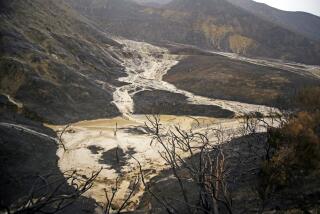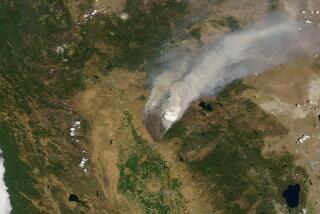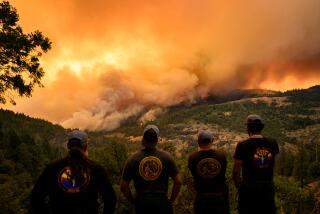Rim fire taking ecological toll over thousands of acres
Standing on ridges miles away from the Rim fire, John Buckley has traced the path of the huge Sierra Nevada blaze by watching fire clouds billowing above the Stanislaus National Forest.
The view has been sobering. As the Rim blaze burns its way into the record books, Buckley thinks it is roasting some of the last remaining old-growth stands in the Stanislaus forest, incinerating thousands of acres of young trees planted at a cost of millions of dollars after massive 1987 fires and destroying important nesting areas for California spotted owls and goshawks.
The extent of ecological damage from the Rim fire won’t be known until after it dies out and crews survey the burn area. But given the intensity of the blaze and 200-foot-tall walls of flame shooting up canyons, Buckley and others expect nothing to be left on big patches of mountain chaparral areas and timberland.
“It’s making these incredible hot runs where it’s literally wiping out the forest,” said Buckley, an ex-firefighter for the U.S. Forest Service and head of the Central Sierra Environmental Resource Center, which has worked for more than two decades to protect the region’s ecosystem.
As of Monday evening, the Rim fire was the 11th-largest wildfire in recent California history at nearly 161,000 acres. Most of the fire is burning in the national forest, but about 21,000 acres have been blackened in the western portion of Yosemite National Park, south of the Hetch Hetchy Reservoir.
Winds and this year’s dry conditions have helped the Rim fire grow by leaps and bounds. It is slightly larger than the last conflagration that roared through the area 26 years ago, the Stanislaus Complex, which also occurred in a dry year.
For a variety of reasons, the region is one of the most burned in the Sierra.
The Groveland Ranger District of the Stanislaus forest, where the Rim fire is centered, is in a dry belt that gets less rain and snowfall than land to the north. It has steep canyons cloaked with highly flammable chaparral and grass. And what humans have done — and not done — since settlement has sabotaged the natural fire cycle of the western Sierra.
Although wildfires burned intensely in places historically, scientists say those patches tended to be small. Low-intensity fires crept regularly through the stands of ponderosa pine, fir and incense cedar, preventing dense growth and fuel buildups.
A century of logging and fire suppression changed that. Logging removed most of the more fire-resistant old trees and the U.S. Forest Service’s policy of putting out wildfires promoted the buildup of fuels in stands that regrew in the logged areas.
When UC Berkeley fire scientist Scott Stephens and his research assistants were conducting field studies in the Stanislaus forest earlier this summer, they came across remnant islands of pine and Douglas fir trees that were 400 years old.
The researchers looked at the dense, younger trees surrounding them and figured the old trees would be goners if a fire came through. A few weeks later, their fears have probably been realized.
“When you have remnant, old-growth trees dying, that’s something we should all be concerned about,” Stephens said.
After the 1987 wildfires, the Forest Service also reforested some of the Stanislaus forest burn area with thousands of acres of pine plantations. Now those young tree plantations are thick with uniform growth — perfect wildfire fuel.
“It’s almost like a giant shrub system,” Stephens said of the plantations, adding that most have never been thinned.
Although the Forest Service has approved thinning projects, it hasn’t had the money to conduct many of them. Stephens said Stanislaus forest staff have told him that “we have no appropriation of dollars to do it. So they’re just sitting on the shelf.”
Buckley also said that plans to conduct controlled burns to reduce fuel levels on 7,000 acres of the Stanislaus forest have languished for years for lack of funding.
“If prescribed burning had been done in many of these areas, it would have been easier to stop [the fire] or it wouldn’t have done so much damage,” Buckley said.
Noting that the taxpayers’ tab for fighting the Rim fire is $20 million and growing, he said there was good reason “‘not to wait until there’s a massive fire and then throw money at it.”
The regional office of the Forest Service was unable Monday to provide details about funding or the rate of fuel-treatment projects on the Stanislaus forest.
Wildfires don’t burn uniformly. Some areas within a fire perimeter will escape fire. Some portions will burn lightly and some acreage will burn so intensely that it is wiped clean of vegetation.
Historically, Stephens said, intense burn patches in the western Sierra would have usually amounted to a few acres, but could be up to 40 acres. On the Rim fire, he is expecting those denuded areas to be hundreds of acres, with some reaching 1,000 acres.
Chad Hanson, an ecologist and director of the John Muir Project of the Earth Island Institute, argues that there is evidence that large, intense burns like the Rim fire sometimes occurred historically in the western Sierra and play an important ecological role.
Insects, including a native beetle with infrared receptors to detect fire, eat the blackened trees. The bugs attract birds. The new growth that sprouts after a fire provides forage for deer and bears. Spotted owls will use stands that escaped the fire as a bedroom and use the burn area as a kitchen as small mammals move in.
“We have all these species that depend on this,” he said. “You have this very, very rich system that develops.”
More to Read
Sign up for Essential California
The most important California stories and recommendations in your inbox every morning.
You may occasionally receive promotional content from the Los Angeles Times.










